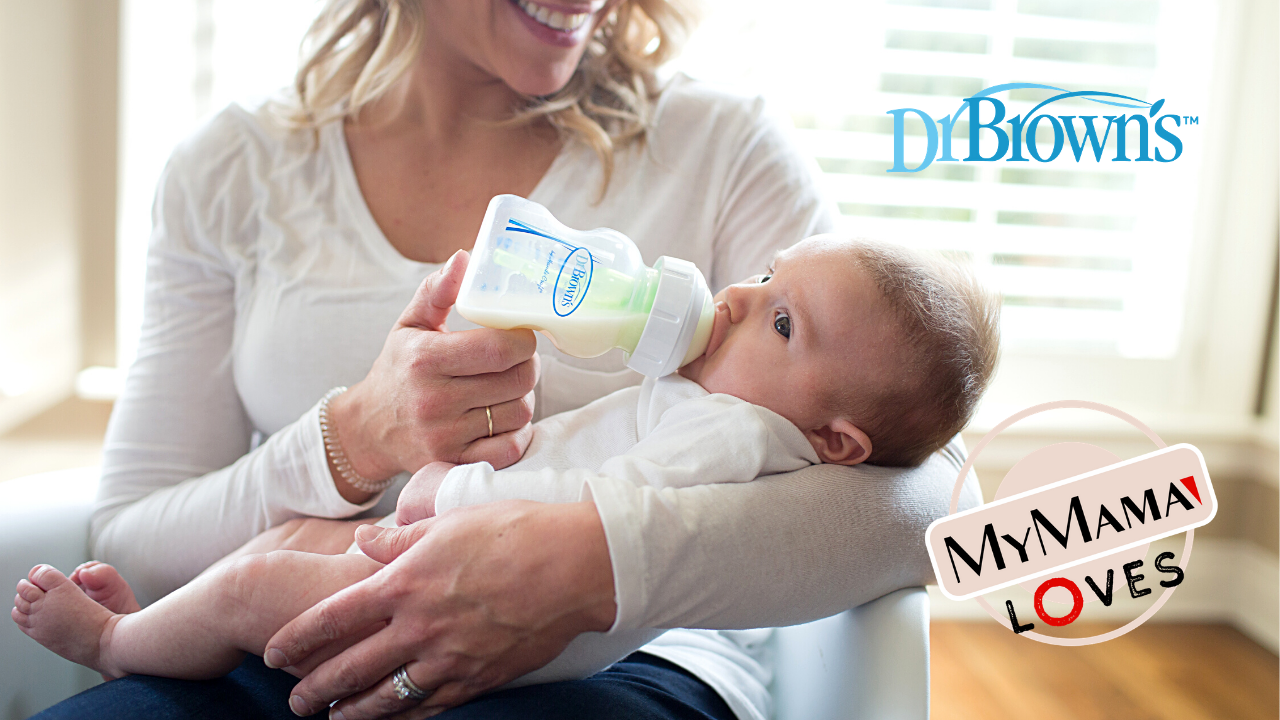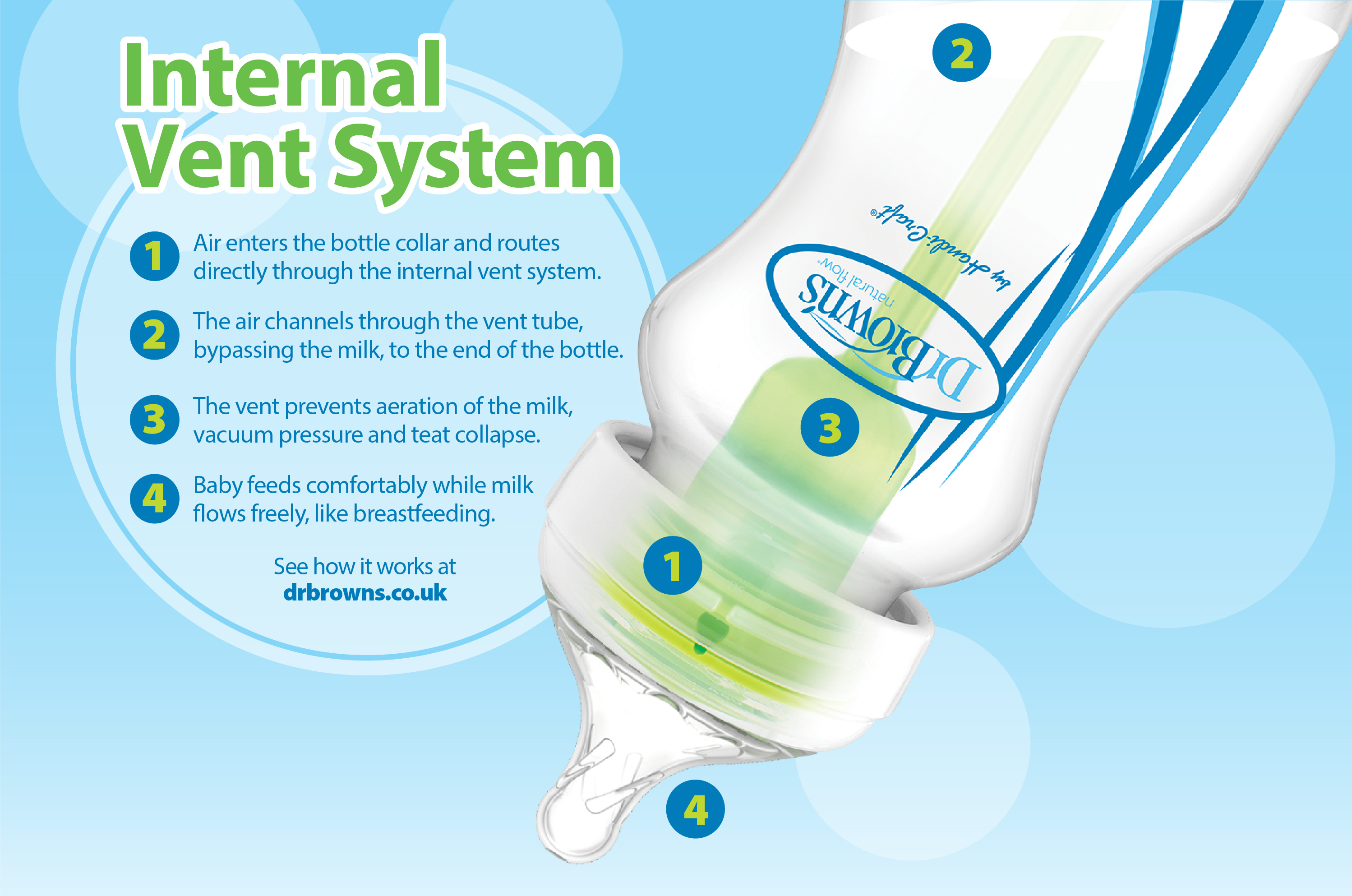MyMama LOVES: Dr. Brown's Anti-Colic Bottles

Tried-and-tested by millions of mums, number one paediatrician-recommended anti-colic bottle brand Dr. Brown's needs no introduction. These are not the bottles with pretty designs that you wish to have amongst your baby supplies - they're the bottles you wish you knew about. Read on to learn why Dr. Brown's anti-colic bottles get the MyMama LOVES seal of approval.
Colic, spit-up, burping and gas – how to get your baby's discomfort issues under control.
We know how helpless you feel when your baby is crying uncontrollably. Even more so when whatever you do does not seem to provide any relief. If this is the case, it could be that your baby is suffering from colic, gas, acid reflux, or a combination of these conditions. In this article, we’ll share tried and tested remedies to help ease your baby’s colic which will give your baby (and you!), the serenity you deserve.
What is colic? How can a parent recognise the symptoms?
With severe colic affecting almost half of newborn babies in the UK alone1, this condition remains one of the most talked about topics by parents and pediatricians. A baby suffering from colic is universally defined as a baby that cries for 3 or more hours a day, 3 or more days a week or 3 or more weeks a month, for no apparent reason. It normally affects babies between 3 to 6 weeks of age but in some cases may persist along the first 3 to 4 months. In any case, we must recognise that colic is a temporary condition which will improve over time.
While the cause of colic is not fully understood, it is generally attributed to one or a combination of the following factors:
- Overstimulated senses
- Hunger
- Underdeveloped digestive system
- Overfeeding
- Acid reflux
- Food allergies / sensitivity
- Swallowed air during feeding and crying
In order to determine if your baby is suffering from colic, look out for these symptoms:
- High intensity crying which is more of an expression of pain
- Crying for no apparent reason
- Restlessness even when crying has subdued
- Most episodes occur in the evening
- Sudden reddening of the face or paleness around the mouth
- Tense muscles such as stiffened legs, arms, clenched fists, arched back or a tense abdomen
- Increased bowel activity, passing gas or spit up
The type of crying related to colic is usually louder, more intense and higher-pitched than normal crying. A reduction of these symptoms may occur once the baby passes gas or has a bowel movement. Gas is likely caused by swallowed air during feeding or prolonged crying periods.
Tips for calming a colicky baby
Swaddling: Your baby may be comforted by tight swaddling such as in a blanket or held close in a baby carrier. Skin to skin contact or massaging your infant may also help. Another technique is to hold your baby face down on your forearm, belly side down, whilst supporting their head. Use your other hand to hold them back in place, and apply a delicate amount of pressure with your hand underneath their belly.
Noise and environment: Keep in mind that your child has recently left the environment of the uterus, where sounds are said to be amplified. That is why certain rhythmic sounds may soothe your restless baby. Try white noise from a radio, the hum of a vacuum cleaner or washing machine. With some luck, the motion of a car or stroller ride may also have a soothing effect. In fact, there are products on the market which aim to replicate the sounds and motion of a car ride. These can be attached to the stroller or crib for maximal effect.
Experiment with your diet: If you’re breastfeeding, consider taking a break from gas-inducing foods such as cabbage and cauliflower. Also limit caffeine intake and spicy foods. If you see no marked improvement in your baby’s behavior, than you may return to your usual diet.
Get out the gas: Gas is thought to be one of the main causes of colic. Hold your baby’s legs up towards his/her chest for a few minutes to get rid of it. Burping during and after feeding may also help. If bottle feeding, it is recommended you switch to a specialised anti-colic bottle.
Take a break: The problem with colic doesn’t just affect babies, but also the parent having to deal with this seemingly relentless condition. Take care of yourself and your mental health – seek guidance and advice from a family member or friend who perhaps has been through this situation with their own child. But in any case having someone to talk to really helps. Remember… you are not alone!
How do Anti-Colic Bottles Help?
There are several issues which are thought to cause colicky symptoms, but 78% of healthcare professionals agree that the most common cause of colic in young babies is caused by digestive or feeding problems, including swallowing air and trapped wind1. Therefore, simply preventing baby from swallowing air can be extremely beneficial in helping avoid wind related colic, such as choosing the right baby bottle.
Anti-colic bottles were invented to reduce colicky symptoms. This is done by reducing gas swallowed during feeding, lessen gas bubbles in the stomach, and slow down the feeding rate. Different anti-colic bottles go about this in different ways. Common design features include:
- Valve system to avoid creating a vacuum
- Restricted nipple flow arrangements
- Teat design to prevent air flowing into the milk
- Angled bottles
- Internal vent to prevent air bubbling through the milk
Switching to Dr. Brown’s Options+ Anti-Colic Bottles
Invented by Dr. Craig Brown in the 90’s, these bottles redefined feeding by introducing an internal vent system that prevents air from coming in contact with milk. This helps prevent colic, spit-up, burping and gas –reducing or eliminating feeding problems for your baby, and stress and anxiety for you! Additionally, essential vitamins like A, C, and E are preserved because air never mixes with the milk.
While other bottle designs have emerged to address venting, Dr. Brown’s are the only bottles that are fully vented. This maximizes your baby’s ability to feed comfortably at their own pace since consistent teat flow is ascertained.
In addition to the original bottles, Dr. Brown’s recently introduced the Options+ bottle, which can be used with or without the internal venting system. You may find that removing the venting system simplifies things for you as your baby’s feeding becomes more developed.
With over 20 years’ experience in helping mums to combat windy colic, Dr. Brown’s and have received numerous awards and acclaim from the medical community. Many Dr. Brown's bottles go to hospitals, NICUs, and doctors’ offices. Mums have voted Dr. Brown’s the best baby bottle for over a decade. They are the number 1 choice of UK healthcare professionals for the relief of colicky symptoms. Dr. Brown’s is also the #1 Pediatrician Recommended baby bottle in the United States.

Colic... and more. About Dr. Brown's Specialty Feeding Range
Dr. Brown’s® Specialty Feeding System was designed in collaboration with medical professionals seeking an oral feeding solution for infants identified with complex feeding challenges such as those often observed in infants with cleft lip and palate, ankyloglossia, high-arched palate, oro-neuromotor dysfunction, common or rare syndromic sequences and/or craniofacial anomalies.
Features of these specialty bottles include:
- Consistent and reliable teat flow rate
- More typical placement of the bolus vs. being manually expressed into the oropharynx
- Requires minimal assembly, which provides confidence and competency with parents/caregivers
- Available in retail outlets, clinics and pharmacies
- Helps decrease gassiness/air intake and burping with non-squeeze method
- Exhibits the essential qualities of Dr. Brown’s Natural Flow bottle by assisting with digestion and preserving vitamins A, C, and E
- Looks like a typical feeding bottle design
- Easy to clean – dishwasher, sterilize, autoclave safe
- Fully reusable system
- BPA free
Why you should think of adding an anti-colic bottle to your hospital list...
With more than a third of newborn babies suffering from colic, we recommend that at least one anti-colic bottle is bought when preparing your hospital list. With multiple international awards and testimonials from mums and professionals worldwide, trust in Dr. Brown’s baby bottles – the #1 Paediatrician Recommended Baby Bottle.
Dr. Brown's products are imported and distributed by Nursery Direct.
Visit www.nurserydirect.com.mt for more info and to purchase online.
References
1: On the Physics of the Infant Feeding Bottle and Middle Ear Sequela, Ear Disease in Infants Can be Associated with Bottle Feeding - Craig Brown, M.D., D.A.B.F.P. et al.
